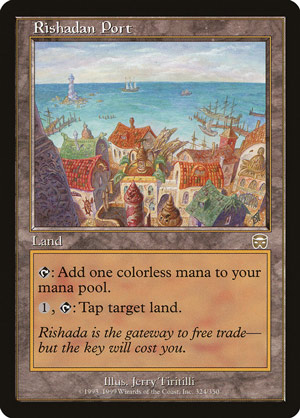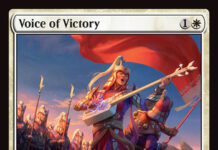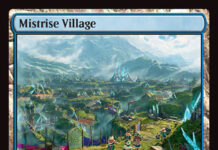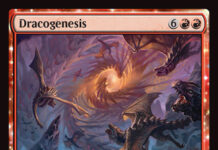
Rishadan Port – Mercadian Masques
Date Reviewed: April 13, 2023
Ratings:
Constructed: 4.13
Casual: 2.25
Limited: 2.00
Multiplayer: 3.00
Commander [EDH]: 3.25
Ratings are based on a 1 to 5 scale. 1 is bad. 3 is average. 5 is great.
Reviews Below:
Years ago, I read something that described Mercadian Masques, as a block, as being focused on doing Nothing. When you look at what the most powerful cards from the three sets are, they tend to largely have this weird theme of stopping opponents, either proactively or reactively, and Rishadan Port (one of the chase cards of the set, even to this day) perfectly encapsulates the overall Mercadia theme of trying to do Nothing.
One mana lets you lock down a land, an excellent way to trip up an opponent if you pin their land down during their upkeep. The overall idea is to tie down an opponent’s mana long enough to get the time you need to set up and take them out, whether it’s through pinpoint denial of specific colors or specific lands. When it’s no longer as effective there, it can just go back to being a land, and it’s not awful at that overall, but it can always be used to block a problem land like Maze of Ith or keep a multi-mana land like Gaea’s Cradle from being used as effectively.
Rishadan Port is not for every deck, as it really demands a deck able to take advantage of the openings it creates in the turns you slow an opponent down. It’s certainly frustrating to play against if you’re not used to it, and it’s a key piece in keeping decks honest at times in a very powerful format and a potent control weapon overall.
Constructed: 4.25
Casual: 2.5
Limited: 2 (it doesn’t really have great targets to hit, and that sort of resource denial is less effective without the weapons to capitalize)
Multiplayer: 3 (you only hit one land, but sometimes it’s a valuable one to hit)
Commander [EDH]: 3.5 (same deal as above: make it count, and you’ll reap the rewards)
Rishadan Port is a fascinating card. It has so little game text and so much depth; so little apparent function, but so much history in tournaments and Magic lore. It reminds me of the way the original Sligh decks used actively bad creatures to somehow win games – except that it turns out that Rishadan Port’s fundamentals are much better than those creatures’ are. Remember, being a land means it can’t be countered and requires specific removal like Stone Rain or Wasteland. Using an activated ability rather than a spell was also very hard to stop in those days, as its original heyday was before the likes of Stifle. When your curve is low enough, you don’t even notice having to tap two lands each turn to get rid of an opponent’s key land or keep them off one color, and in decks with that appropriate mana curve, there’s basically no cost to including it at all.
Aside from the discussions about power creep or just creature creep or whatever you want to call it, I’m kind of glad there are fewer cards nowadays which trick you as blatantly as some older ones did. A few is fine, but it can get frustrating when you genuinely don’t know whether the booster pack you opened is good for your deck or not. There’s videos out there where people show Magic cards to people who have only played other TCGs and ask them to decide if they’re any good – it seems like another card game should prepare you for that kind of assessment, but older cards often trip them up.
Constructed: 4
Casual: 2
Limited: 2
Multiplayer: 3
Commander [EDH]: 3
We would love more volunteers to help us with our Magic the Gathering Card of the Day reviews. If you want to share your ideas on cards with other fans, feel free to drop us an email. We’d be happy to link back to your blog / YouTube Channel / etc. 😉
Click here to read over 5,000 more MTG Card of the Day Reviews!
Daily Since 2001.




